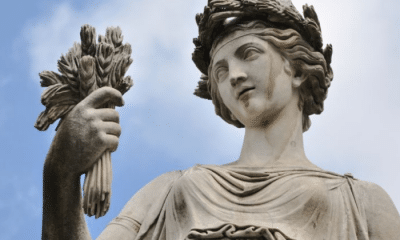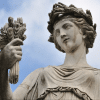Roman
Vulcan: The Roman God of Fire
The Roman god Vulcan was much more than a smith. Read on to find out why the Romans loved and feared him as the god of fire!
Unlike many other cultures, Roman mythology did not develop over a long period of time. Instead, the people of early Rome adopted the legends of their neighbors almost entirely as they had been told by the Greeks.
While the myths remained the same, the gods were somewhat different. The Roman names were those of earlier Italian gods, whose influence was still seen in the Greco-Roman myths.
One of these gods was Vulcan. His mythology had been based on the Greek god of smithing, Hephaestus.
Vulcan’s Italian origins, however, made him an influential god in a way he had not been throughout most of Greek history. While he was still a smith, he was more broadly seen as the Roman god of fire.
This domain made Vulcan a god who was both loved and trusted by the Romans. While he made the soil richer and protected the city, he could also represent a destructive force.
From the God of Smiths to the God of Fire
Hephaestus was the Greek god of metalworking. He was the patron of smiths who made the weapons and armor of the gods and heroes.
Like most Greek gods, Hephaestus was combined with local deities when he was adopted by the Romans. He was renamed Vulcan, or Vulcanus.
When the Greek gods were combined with those of Italy, their mythology was largely the same as it had been in Greek literature. Many of their attributes and domains, however, were subtly different than in the past.
The Roman Vulcan remained a god of smithing, but became more closely associated with fire than he had been in Greece.
Most historians believe that the Italian god Vulcan was partially based on had not been a craftsman, but had instead been a more elemental deity of fire. The early Italian gods did not have the human characteristics that those of Greece did, so they would have had no need for the weapons and armor a smith would create.
This god was associated with Hephaestus because of the use of fire in metalworking. Vulcan always remained closely tied to the elemental form of fire in Roman thought.
The Greeks, for example, had believed that volcanoes were caused by giants that had been imprisoned in the earth. The Romans widely believed that Mount Etna and other peaks were forges of Vulcan and were under the fire god’s domain.
Vulcan was also connected to agriculture and fertility far more than Hephaestus had ever been.
Ash was used as a fertilizer in the ancient world, and the people of Italy could look to their own landscape to see the benefits of volcanic ash. The fires of Vulcan, therefore, were associated with agricultural prosperity.
Those same fires could also be destructive, of course. Far more than Hephaestus, Vulcan was seen as a god who had to be appeased.
The Vulcanalia, his festival, was held at the height of summer. It combined both the reverence of fire as a life-giving element and the danger that was associated with it.
The festival of the Roman god of fire was timed for the hottest, driest part of the year. In August, Roman crops and grain stores were at high risk from quick-spreading fires.
To appease Vulcan during this dangerous time, fish and small animals were thrown into bonfires. It was hoped that the god of fire would accept these sacrifices rather than causing humans to be burned alive.
My Modern Interpretation
The Roman god of fire was seen as a far more dangerous and violent god than his Greek counterpart. This could be seen, in part, as due to differences between the two cultures.
While the Greeks established many great cities, none were as large or densely-populated as Rome. The threat of fire was a major concern in the city of Rome.
Vulcan was a god who could avert this threat in Roman thought, but great care was still taken to minimize the chance of fire in the city. One precaution was to keep the god of fire at a distance.
The Etruscan haruspices, or prophets, had insisted that the shrine of Vulcan should be located outside of the city because of its dangers. If the Roman god of fire ever grew angry with his people, they feared that a temple within the city could serve as the starting point for a devastating fire.
Despite this warning, the Vulcanal shrine was in the heart of Rome, at the foot of the Capitoline Hill and within the Roman Forum.
The Vulcanal was one of the city’s oldest shrines, however. Supposedly dating back to the 8th century BC, it likely predated the expansion of the city into that area.
It was probably that the shrine of Vulcan was originally located outside of the city’s walls. The Roman god of fire was kept at a safe distance from the archaic city.
Even as the city expanded, Vulcan was kept separate. His shine was in the center of the city, but space was carefully maintained around it so fires could not easily spread.
When a new temple was eventually built sometime in the 3rd century BC, it was placed outside the city walls once again. Its placement on the Campus Martius kept the city safe in more than one way.
The temple of Vulcan was placed on Mars’ field even though the two gods were rivals for the love of Venus. The Romans hoped, however, that the god of war and the god of fire would work together in the common goal of keeping the city safe from outside threats.
Neither city planning nor sacrifices could keep a city such as Rome entirely safe from the treat of fire, though. Buildings were often destroyed and finally, in 64 AD, a devastating fire engulfed much of the city.
The Great Fire of Rome raged for ten days and burned nearly two-thirds of the city’s buildings. Tens of thousands were left homeless and the city’s economy suffered for years.
Different sources through the years blamed Emperor Nero, religious sects, speculators, and looters for the spread of the flames. Most Romans could agree, however, that the fire had been allowed to cause so much devastation because of Vulcan.
After the city was rebuilt, Emperor Domitian made sure to appease Vulcan. A new temple was established and the sacrifices given during the Vulcanalia were expanded to ensure that the city never burned again.
In Summary
The Roman god of fire was Vulcan. His mythology had been inspired by the Greek metalworking deity, Hephaestus.
The pre-Roman Italians, however, had worshiped much less human-like gods than the Greeks. Their pantheon had no dedicated craftsman, but it did have a powerful god of fire.
Vulcan was associated with both the positive and negative qualities of fire.
As a smith, he used fire to create tools, armor, weapons, and luxury items. His fires were constructive and well-contained.
He was also a god of fertility. Ash, whether from controlled fires or the Italian volcanoes, enriched the soil.
The fires and volcanoes he was associated with also had a destructive aspect, however. Vulcan’s fires could destroy crops, burn houses, and kill people who were caught in their path.
Efforts to appease Vulcan were at the center of his worship in Rome. Because the city was large and densely-populated, fire was a constant threat.
Vulcan’s temples and rituals were placed outside of the city or physically isolated from other buildings. Sacrifices were thrown into fires in his name in the hopes that he would accept them rather than demanding human lives.
These efforts were not always successful, and fires broke out in the city with some frequency. The Great Fire of Rome in 64 AD was the most devastating, resulting in the destruction of two-thirds of the city.
In response to this, the Romans redoubled their efforts to appease the god of fire. Vulcan’s anger had destroyed the city, but the people of Rome always hoped that his favor would spare it from more harm.



